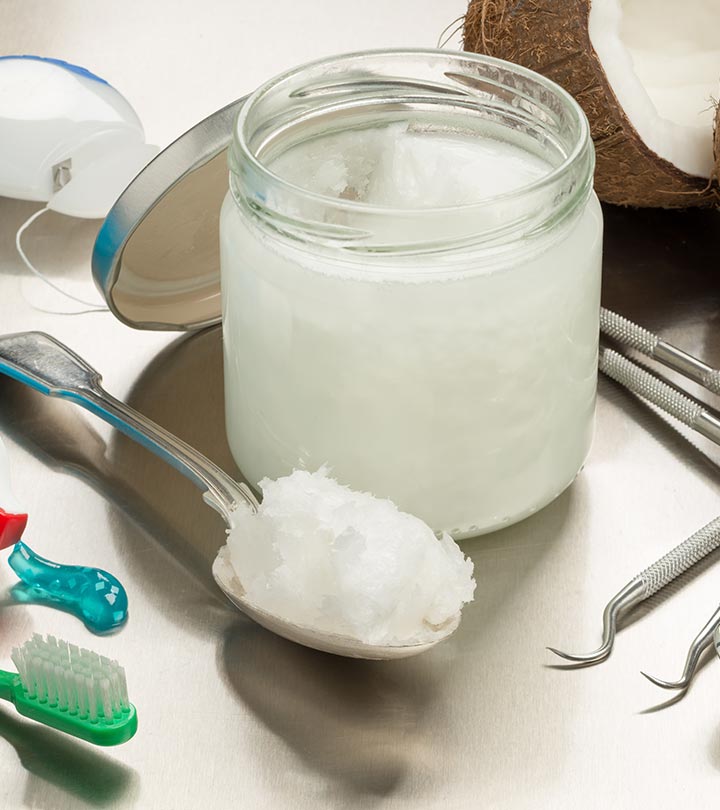300x600

Oil pulling is the practice of swishing oil in the mouth for extended periods. It is believed that by swishing or holding oil in your mouth, you can get rid of oral pathogens. Oil pulling can also release the oil-soluble (water-insoluble) toxins in your body.
There are many proponents of oil pulling. But, as a technique, it has received a lot of flak from the medical fraternity. There is ongoing research to establish the disadvantages of oil pulling. We’ve compiled a few proven side effects in this article. Take a look.
What Is Oil Pulling? How Does It Work?
Oil pulling is a powerful detoxifying Ayurvedic technique. It has recently become popular as a complementary and alternative medical (CAM) remedy for different health ailments (1).In this technique, you swish and gargle edible oil in your mouth for 5-10 minutes and spit it out.
Ayurveda claims oil pulling to be effective against 30 systemic diseases ranging from headache, migraine, diabetes to asthma. However, traditional medicinal practices can prove to be harmful. Though there are a few, these side effects can be life-threatening if left unnoticed.
Curious?
Read on to know the major side effects of oil pulling.
What Are The Side Effects Of Oil Pulling?
1. Lipoid Pneumonia
Lipoid pneumonia is caused by aspiration or inhalation of oily substances. It is a lung disease that could affect people who try oil pulling.When you mistakenly swallow or inhale a large amount of swishing oil, it enters your air passages and lungs. Since this oil could be contaminated with oral pathogens and toxins, it might cause lipoid pneumonia.
2. Stomach Upset And Nausea
This ancient technique might cause an upset stomach and diarrhea. Gargling and swishing large amounts of dense oils like coconut oil can make you feel nauseous. Swallowing these contaminated oils can mess with your stomachThis is why a majority of healthcare providers believe oil pulling is not an effective technique. Brushing your teeth and flossing regularly remove more debris than oil pulling.
3. Heavy Metal Poisoning
Most of the Ayurvedic medicines have achieved incredible results. Traditional and herbal medicine is potent and safe. But certain Ayurvedic preparations have been reported to have traces of heavy metals.Lead, mercury, and arsenic intoxication are often associated with the use of Ayurvedic herbal medicine product (HMPs) .
Users of Ayurvedic medicine may be at risk for heavy metal toxicity. Researchers at the Harvard Medical School recommend heavy metal testing to be made mandatory for all Ayurvedic products.
Since oil pulling has its origin in this traditional medicine, the products used in the technique may possess heavy metal traces .
However, Ayurveda practitioners assure complete safety. According to them, only after due traditional purification process is strictly followed is an herbal medicinal product put to use.
These effects sound scary. But why does this procedure have a huge fan base?
Probably because there are ways of avoiding these side effects. Check the next section for more information.
How To Avoid The Side Effects Of Oil Pulling
Many of the side effects of oil pulling are caused because of practicing the technique the wrong way. This could be one of the better ways of performing oil pulling:- Brush your teeth normally after waking up. Make sure you clean your tongue and rinse your mouth properly.
- Take 10 ml of sesame or coconut or sunflower oil and raise your chin marginally. This will cause the oil to spread around the inside of your mouth.
- Use your tongue to apply the oil to the gaps between your teeth, gums, and palate.
- Move your jaws in a chewing motion.
- Continue the process for about 5-10 minutes.
- You will notice the oil becoming more watery. You need to spit out the oil at this point.
- Do not swallow this oil. If you did in small amounts, it would get washed off in urine and stools. But if it is in large amounts, see a doctor at the earliest.
- Rinse your mouth thoroughly with tap water.
- Wait for 15- 20 minutes before you eat or drink anything.
Here comes the crucial part. These are the precautions you need to keep in mind:
- Children under the age of 5 should not be allowed to perform oil pulling.
- If you are allergic to sesame, coconut, sunflower, or any oil that’s being used, or a particular brand of oil, pick another type. If not, refrain from practicing this technique.
- Lastly, if the oil does not turn thin and white, you might not be performing oil pulling correctly.
- The best way is to perform this exercise under an experienced practitioner. Do it under medical guidance until the healthcare provider approves your technique.
The Bottom Line
Nothing replaces the classic toothbrush and paste routine. Although oil pulling is an age-old tradition that has proven to be effective, it has its share of side effects.Unless you are strictly advised against brushing your teeth, it is better you stay away from this technique. It might trigger nausea, diarrhea, or even allergic reactions if done incorrectly. The severity of these side effects is still being investigated, though.
If you have relevant inputs and queries on oil pulling, we’d be happy to assist. Share your suggestions and feedback in the box below.
Not everything old is gold!

0 Komentar